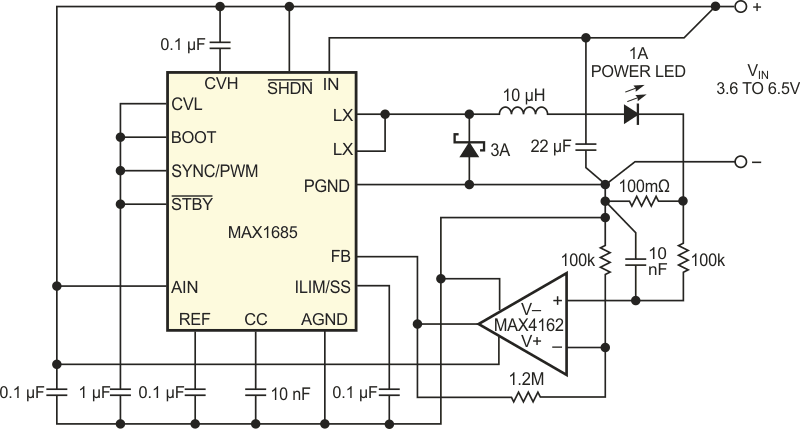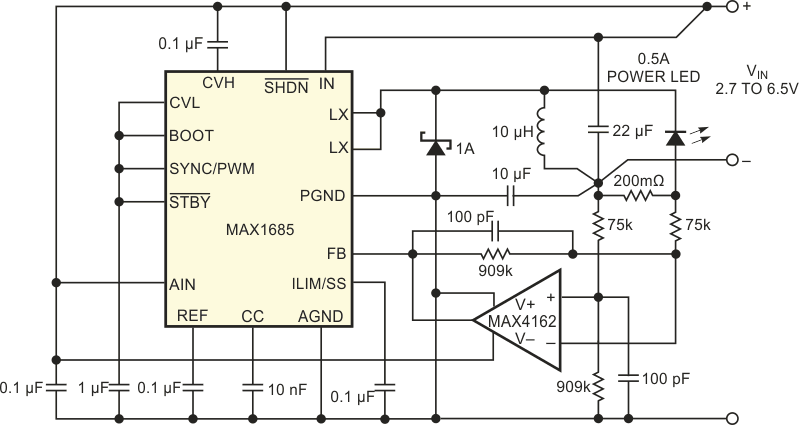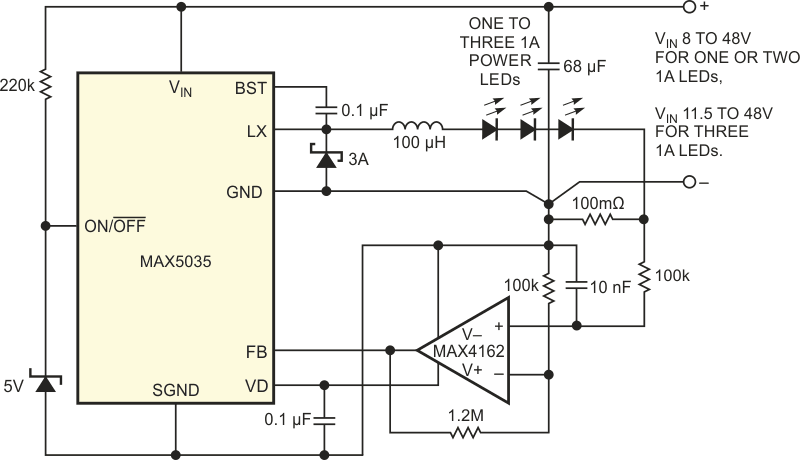As the latest generation of new LEDs achieves higher levels of power and efficiency, use of these devices extends to new areas, such as flashlights and vehicular applications. High-power LEDs are finding use even in ambient lighting, long the sole province of incandescent bulbs and fluorescent tubes. A current source is the best way to power LEDs. Because most energy sources, including batteries, generators, and industrial mains, look more like voltage sources than current sources, LEDs require that you insert some electronic circuitry between them and the source of power. This circuitry can be as simple as a series resistor, but a better choice, considering energy efficiency and other factors, is a high-efficiency, voltage-fed current source. For LEDs with currents greater than 0.35 A, an inductive switching regulator is usually the best choice.
This Design Idea presents a series of circuits based on single-power-IC switching regulators, with efficiency and miniaturization as the main objectives. The circuits’ designers approach these objectives by minimizing the use of large components, such as external power transistors, switches, high-value capacitors, and current-sense resistors, and by maintaining regular operation by delivering constant, high-intensity light over as extended a range as possible.
 |
|
| Figure 1. | This miniature, 1 A, high-power LED driver operates on 3.6 to 6.5 V. |
 |
|
| Figure 2. | Similar to the circuit in Figure 1, this miniature, 1 A, LED driver operates on 3.6 to 6.5 V but requires no current-sense resistor. |
 |
|
| Figure 3. | Another miniature, high-power LED driver delivers 0.5 A and operates on 2.7 to 6.5 V. |
The circuits in figure 1, figure 2, and figure 3 are suitable for applications in which the power source comprises three or four alkaline, NiMH (nickel-metal-hydride), or NiCd (nickel-cadmium) cells. Those in figure 4 and figure 5 are for vehicular applications in which the nominal line voltage for the power-distribution system is 12, 24, or 42 V. The circuits of figure 4 and figure 5 are also useful in industrial systems that include a 24 V distribution line for control and emergency subsystems and in telecom applications for which the system power is distributed as a –48 V line.
 |
|
| Figure 4. | This miniature, 1 A, LED-driver circuit operates on 8 to 50 V and drives as many as three LEDs in series. |
 |
|
| Figure 5. | Otherwise similar to the circuit in Figure 4, this circuit requires no sense resistor. |
The designers of these circuits based them on the same concept: a fully integrated, single-die-IC switching regulator and a micropower operational amplifier. The op amp drives the 1.25 V feedback terminal on the IC. Although that node targets the topology of a standard voltage regulator, the op amp matches it to the much smaller current-sense voltage and the slightly different topology of a current regulator. None of the circuits requires the use of external power switches. The design eliminates the use of the large-valued filter capacitors you usually find in a switching regulator, because there is no need to smooth out high-frequency ripple in the LED current. Common to all circuits is the option of adding a dimming capability by introducing adjustable bias at an op-amp input through a resistor and a potentiometer powered from the internal regulator – the VD or CVL terminal, depending on the IC.
A high-frequency switching regulator powers the basic regulator circuit for LEDs (Figure 1). It operates with input voltages of 3.6 to 6.5 V, drives a single LED with currents as high as 1 A, and uses a current-sense resistor to control the current-regulation loop. The circuit of Figure 2 is similar, but, in place of a current-sense resistor, it employs the parasitic resistance of the inductor as a current-sensing element. Like the circuit in Figure 1, it operates with 3.6 to 6.5 V inputs and drives one LED with currents as high as 1 A.
For the single-LED circuit of Figure 3, the starting voltage of the MAX1685 defines the input range, which goes as low as 2.7 V. Its maximum current capability is 0.5 A versus 1 A for the circuits in figure 1 and figure 2. The upper operating limit remains 6.5 V. Once this circuit is operating, it maintains power to the LED even for input voltages as low as 1.7 V. Applications for the circuits of figure 1, figure 2, and figure 3 include headlights, flashlights, and any other portable lights powered by three or four alkaline primary cells, three or four NiMH/NiCd secondary cells, or a single lithium secondary cell.
The circuits of figure 4 and figure 5 operate over 8 to 50 V. Assuming a 12 V system in which all the components are properly specified, these circuits can survive load dumps, thanks to the 76 V absolute maximum rating for the IC’s input-power terminal, VIN. The maximum available current is 1 A, and the circuits can drive as many as three LEDs in series, provided that you increase the lower limit of the operating range to 11.5 V. These two circuits are similar, except for the use of the inductor resistance as a current sensor in Figure 5. The disadvantage of using the inductor resistance in this way is the resulting dependence of output current on temperature, due to the large temperature coefficient of copper resistivity. The inductor winding is made of copper, and its dc resistance has a first-order temperature coefficient of 3.9 parts/1000/°C. As a result, the regulated current decreases about 4% for each 10 °C increase in operating temperature.